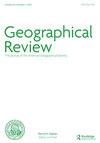数字城市:媒体与场所的社会生产
IF 1.4
3区 社会学
Q2 GEOGRAPHY
引用次数: 21
摘要
当代人文地理学的研究很难脱离技术和我们现在生活的数字环境。今天,社会植根于物联网,因为越来越多的日常生活与算法、应用程序、数字媒体和云联系在一起。那些被排除在网络之外(有意或无意)的人也是地理研究的对象——地理学家分析数字鸿沟的含义,或者分析缺乏技术和数字环境如何影响与在线服务隔绝的社区、被排除在互联网之外的人,以及政府故意设置障碍阻止公民接触数字生活的社会。数字城市在智能城市发展、媒体和通信技术以及文化地理方面的研究问题中找到了一个家。Halegoua是堪萨斯大学电影与媒体研究系的副教授,她并不是地理学家出身,而是从跨学科的角度来看待这些问题。Halegoua将传播学、媒体研究和地理学的文献结合起来,为《数字城市》一书中提出的论点提供信息。因此,本书在分析中并没有采用明确的空间视角,但确实涉及了一些核心的地理概念,主要是空间、地点和无地性,并涉及了城市规划中与地理相关的文献。在整个作品中,Halegoua的主要观点是,之前对城市环境中数字媒体的研究往往局限于个人对媒体的使用。研究表明(Kitchin 2014;Shelton, Zook, and Wiig 2015)媒体如何以及为什么在城市环境中被用作特定问题的解决方案。通过这样做,这些研究有效地将个人日常活动与他们的身体活动空间分离开来——也就是说,我们不再需要去杂货店;相反,只需点击几下按钮,杂货就可以送到我们家里。同样,过去的研究(A. de Souza e Silva等人2011;Ito 2013)讨论了个人与媒体的接触,并试图理解媒体用户如何将应用程序或物理设备用于独特的情况,再次关注使用技术将我们从物理环境中移除。《数字城市》将这些研究向前推进了一步,从理解人们在生活中整合媒体和技术的方式,到这种整合随后如何重塑他们的参与度本文章由计算机程序翻译,如有差异,请以英文原文为准。
THE DIGITAL CITY: Media and the Social Production of Place
Contemporary research in human geography can hardly be divorced from technology and the digital environments in which we now live. Today, society is rooted in the Internet of things, as an increasing amount of everyday life is connected to algorithms, applications, digital media, and the cloud. Those who are left off the grid (intentionally or not) are also objects of geographic studies— geographers analyze the implications of the digital divide or how the lack of access to technology and digital environments has an impact on communities cut off from online services, on people who are shut out from participating with the Internet, and on societies whose governments have intentionally implemented barriers to prevent citizens from accessing aspects of digital life. The Digital City finds a home within research questions regarding smart city development, media and communications technology, and cultural geographies. Halegoua, an associate professor in the Department of Film and Media Studies at the University of Kansas, is not a geographer by training, instead coming to these questions from an interdisciplinary perspective. Halegoua incorporates literature from communications studies, media studies, and geography to inform the arguments presented throughout The Digital City. As such, the book does not take on an explicitly spatial perspective in its analysis, but does engage with some core geographic concepts, mainly space, place, and placelessness, and engages with geography-adjacent literature in urban planning. Throughout the work, Halegoua’s main point is that previous research on digital media in urban environments have often been limited to individuals’ use of media. Studies have shown (Kitchin 2014; Shelton, Zook, and Wiig 2015) how and why media is used in urban environments as solutions to specific problems. In doing so, these studies effectively separate personal daily activities from their physical activity spaces—that is, we no longer need to go to a grocery store; instead groceries can be delivered to our homes with a few button clicks. Similarly, past studies (A. de Souza e Silva and others 2011; Ito 2013) have discussed individuals’ engagement with media and seek to understand how media users appropriate applications or physical devices to unique situations, again focusing on the use of technology to remove us from our physical environments. The Digital City pushes these studies one step farther, past understanding the ways in which people have integrated media and technology within their lives, to how this integration has subsequently reshaped their engagement
求助全文
通过发布文献求助,成功后即可免费获取论文全文。
去求助
来源期刊

Geographical Review
GEOGRAPHY-
CiteScore
4.80
自引率
10.00%
发文量
24
期刊介绍:
One of the world"s leading scholarly periodicals devoted exclusively to geography, the Geographical Review contains original and authoritative articles on all aspects of geography. The "Geographical Record" section presents short articles on current topical and regional issues. Each issue also includes reviews of recent books, monographs, and atlases in geography and related fields.
 求助内容:
求助内容: 应助结果提醒方式:
应助结果提醒方式:


